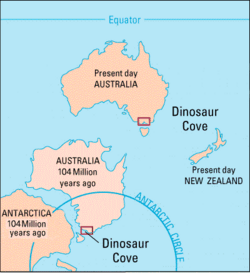Dinosaur Cove facts for kids
Quick facts for kids Dinosaur Cove |
|
|---|---|

During the Cretaceous the site (red boxes) was within the Antarctic Circle
|
|
| Location | The Otways, Victoria |
| Coordinates | 38°46′48″S 143°24′18″E / 38.78000°S 143.40500°E |
| Type | Bay |
| Basin countries | Australia |
Dinosaur Cove is an amazing place in Victoria, Australia. It's on the coast, near the Great Otway National Park. This spot is famous for its incredible dinosaur fossils. These fossils are found in cliffs that are about 106 million years old! Discoveries here have taught us a lot about dinosaurs in Australia and the Southern Hemisphere.
A Look Back in Time
About 106 million years ago, during the Early Cretaceous period, this area was a huge flat plain. It was part of a giant valley that formed as Australia slowly pulled away from Antarctica. Over time, sand, mud, and silt covered the remains of dead animals and plants. This helped to preserve them.
As the valley slowly sank, more layers of dirt piled up. All this pressure turned the dirt into hard rock. In the last 30 million years, these rocks have been pushed up to form the Otway Ranges. This brought the fossil-filled layers closer to the surface again. The best dinosaur bones are found in thin layers, often in what used to be ancient stream beds. These spots collected the bones of smaller animals.
How Dinosaurs Were Found Here
The first dinosaur fossil in Australia was found in 1903. A geologist named William Hamilton Ferguson was exploring the coast near Inverloch. Many years later, in the 1970s, the real work began at Dinosaur Cove. Teams of volunteers, led by Tom Rich and Patricia Rich, started digging.
They even used heavy mining equipment and dynamite! This helped them blast away the hard rock layers to reach the fossil-rich areas. Two dinosaur species found here are named after the Rich's children: Leaellynasaura amicagraphica and Timimus hermani.
The rocks at Dinosaur Cove were buried very deep for a long time. The heat and pressure made them super hard. So, to find fossils, workers had to break each rock lump with a sledgehammer. After each hit, they carefully checked the broken surfaces for any signs of bone. If they found bone, the piece was sent to a lab. There, experts carefully removed the fossil from the rock.
Dinosaurs of the Polar Region
In the 1980s and 90s, Dinosaur Cove gave us some amazing finds. These included small plant-eating dinosaurs like Leaellynasaura amicagraphica and Atlascopcosaurus loadsi. They also found a meat-eating dinosaur called a Coelurosaur. There were even pieces of what might be a caenagnathid, which are relatives of the Oviraptor.
These dinosaurs are sometimes called "polar dinosaurs of Australia". Scientists think some of them might have had special eyesight to see in low light. They also might have been warm-blooded. This could have helped them find food during the dark polar winter months.
It's important to remember that the climate during the Cretaceous period was much warmer than today. Even though these dinosaurs lived near the South Pole, it wasn't as cold as Antarctica is now. Ocean currents and winds helped keep the polar areas warmer back then.
One exciting discovery was a bone from a large meat-eating dinosaur. It was first thought to be an ancient relative of Allosaurus. But now, scientists believe it belonged to a megaraptoran. This was the first time such a bone was found in the Southern Hemisphere!


